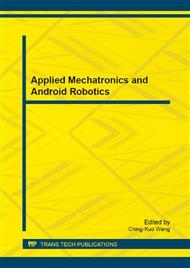p.225
p.229
p.234
p.238
p.242
p.246
p.250
p.257
p.261
Dynamic and Analysis of a Marine Stabilization Table
Abstract:
The purpose of this research is to design and construct a marine stabilization table. This table is fixed on a ship and can be self-balanced when the ship is moving in the sea. The stabilization principle bases on gyroscopic force created by a flywheel. The study also uses ADAMS software to simulate and analyze the virtual model. The analysis result shows that with a flywheel of 33 kg and a flywheel spinning speed of 3000 rpm, the maximum tilt angle of tabletop is 6.160 when an 5 kg object is placed on edge of the one-meter-diameter tabletop. A prototype of marine stabilization table is also manufactured in this research.
Info:
Periodical:
Pages:
242-245
Citation:
Online since:
September 2013
Authors:
Price:
Сopyright:
© 2013 Trans Tech Publications Ltd. All Rights Reserved
Share:
Citation:


